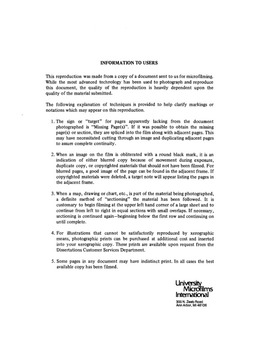| dc.contributor.author | Yaden, David B. | en_US |
| dc.date.accessioned | 2013-08-16T12:28:45Z | |
| dc.date.available | 2013-08-16T12:28:45Z | |
| dc.date.issued | 1982 | en_US |
| dc.identifier.uri | https://hdl.handle.net/11244/5043 | |
| dc.description.abstract | Not confirmed were the hypothesized individual effects of reading ability and intelligence on print awareness scores. With intelligence controlled, individual measures of reading accounted for less than 20% of the variance of print awareness. With reading controlled, intelligence accounted for less than 10% of the variance. In combination, however, measures of reading achievement, intelligence and gender accounted for approximately 40% of the variance in print awareness as measured by the CAPT. | en_US |
| dc.description.abstract | Subjects for the study were 118 all white first grade students, 62 female and 56 male, from a predominantly middle class, metropolitan school district. Students were individually interviewed with the Concepts About Print Test during April. Other measures included were the Otis-Lennon School Ability Test and the Stanford Achievement Test. Statistical analyses performed were a multiple regression of print awareness on measures of reading ability, intelligence and gender, partial correlations between reading, intelligence and print awareness, a one-way MANOVA comparing above and below average readers on previously identified factors in the Concepts About Print Test (CAPT) and intelligence and, finally, a canonical correlation between aspects of print awareness and measures of reading ability. | en_US |
| dc.description.abstract | The purpose of the investigation was in part to replicate with a larger sample size previous findings that children demonstrate certain confusions about printed conventions and that above average readers perform better on measures attempting to assess knowledge of printed conventions. The study in addition set out to measure the contribution of intelligence to both print awareness and reading achievement and to test for the presence of certain hypothesized effect sizes to more precisely define the relationship between print awareness, reading ability and intelligence. | en_US |
| dc.description.abstract | In general, the study supported the findings of previous research that some beginning readers' concepts of letters, words and marks of punctuation are not stabilized even after one year of reading instruction. Significant differences were found between types of readers on the measure of intelligence and on items of the CAPT representing directional habits and pertaining to the identification of incorrect word and letter sequences and punctuation. No sex differences were found on any variables measured in the study. | en_US |
| dc.format.extent | x, 102 leaves ; | en_US |
| dc.subject | Education, Reading. | en_US |
| dc.title | A multivariate analysis of first graders' print awareness as related to reading achievement, intelligence and gender. | en_US |
| dc.type | Thesis | en_US |
| dc.thesis.degree | Ph.D. | en_US |
| dc.thesis.degreeDiscipline | Jeannine Rainbolt College of Education | en_US |
| dc.note | Source: Dissertation Abstracts International, Volume: 43-06, Section: A, page: 1912. | en_US |
| ou.identifier | (UMI)AAI8225520 | en_US |
| ou.group | Jeannine Rainbolt College of Education | |
